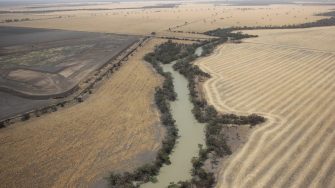
Date: Saturday, November 15, 2014
Project: Eastern Australian Waterbird Survey
Observer: Richard Kingsford
Out of Sydney and heading north to work our way around all the major wetlands in the Murray-Darling Basin. We are now building up a picture over a number of years of what is happening on the wetlands supplied by all the rivers of the Murray-Darling. The waterbirds, in the parlance of management, are a basin-wide indicator of river and wetland health.
We flew direct to Moree on the lower end of the Gwydir River catchment. It was hot. By far the hottest day we had experienced this year and for many years. There are two thermometers in the plane one within the plane and the other in the sun. The one in the plane showed 46oC and the one measuring outside temperatures was over 50oC. To make matters worse there was a 20-30 knot wind from the west.
The Gwydir branches at Moree, one branch of the river going south and another north. We headed south along the Meehi River and Mallowa Creek.
Surveying along the Meehi River
Here there are crops planted alongside the river. There was only one small spot of wetland where there were a few birds on this southerly river system.
The Meehi River, flanked by cereal crops, along the southern floodplain of the Gwydir River
Surveying along the Meehi River
Then back along the Gwydir watercourse. This was once an extensive wetland system, one of the best of the Murray-Darling Basin. It is now a shadow of its former glory because it now gets much less water than it used to before irrigation established in the catchment upstream. Now much of the water that used to reach the wetlands is diverted.
Highly fragmented Gwydir wetlands
At the same time, landholders in the Gwydir wetlands started to crop the floodplain so that there are little pockets of wetland.
Wetlands of the upper Gwydir from the gopro camera on the wing of the plane
A small environmental flow had come through and so you could see what a magnificent system this wetland still is in small areas.
Lagoons of water and aquatic vegetation on the Gwydir wetlands
There were a scattering of waterbirds all through these wetlands, including grey teal, yellow and royal spoonbills, black duck, and even a few brolgas and a jabiru. Always great to see these elegant birds down in New South Wales. They once occurred reasonably frequently further south, even down to Sydney.
Surveying the Gwydir wetlands
Our final survey line was from the west along the Gwydir River where just east of Moree, there is an area called the raft where hundreds of logs are stacked up from clearing that happened in the early 1900s for fifteen kilometres. This has the effect of pushing floodwater out across the floodplain to the Gingham watercourse.
We finished in the late afternoon – something about mad dogs and Englishman in the midday sun came to mind.
